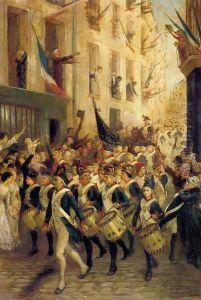Henri-Charles-Etienne Dujardin-Beaumetz Paintings
Henri-Charles-Etienne Dujardin-Beaumetz was a French artist, born in 1852 in Saint-Quentin, Aisne, France. His career spanned the late 19th and early 20th centuries, a period marked by significant developments in European art, including the transition from traditional academic painting to the early stages of modernism. Dujardin-Beaumetz was primarily known for his work as a painter, though his interests and contributions extended into the realms of politics and medicine, reflecting a multidimensional personality that was somewhat characteristic of Renaissance men but found in the modern era.
Educated in the fine arts, Dujardin-Beaumetz developed a style that, while rooted in the academic tradition, demonstrated a keen observation of light and shadow, often focusing on landscapes, still lifes, and interior scenes. His approach to painting was meticulous and detailed, with a preference for realism that captured the essence of his subjects. Despite the predominance of impressionism and post-impressionism during his lifetime, Dujardin-Beaumetz remained committed to his more traditional aesthetic, which resonated with a segment of the art-buying public that appreciated the beauty and craftsmanship of well-executed representational art.
Beyond his artistic career, Dujardin-Beaumetz engaged in public service, reflecting his belief in the social responsibilities of the artist. He served in various capacities within the French government, including roles related to the arts and public health. This involvement in government allowed him to advocate for policies that supported the arts and public welfare, including the improvement of living conditions for the poor and the promotion of public health initiatives. His work in these areas was motivated by a holistic view of society, where art, health, and well-being were interconnected.
Henri-Charles-Etienne Dujardin-Beaumetz's death in 1913 marked the end of a career that had successfully bridged the worlds of art and public service. While he may not be as widely recognized today as some of his contemporaries, his contributions to French art and society during his lifetime were significant. His paintings, characterized by their clarity, precision, and attention to detail, continue to be appreciated by collectors and art enthusiasts, serving as a testament to his skill and dedication as an artist.




